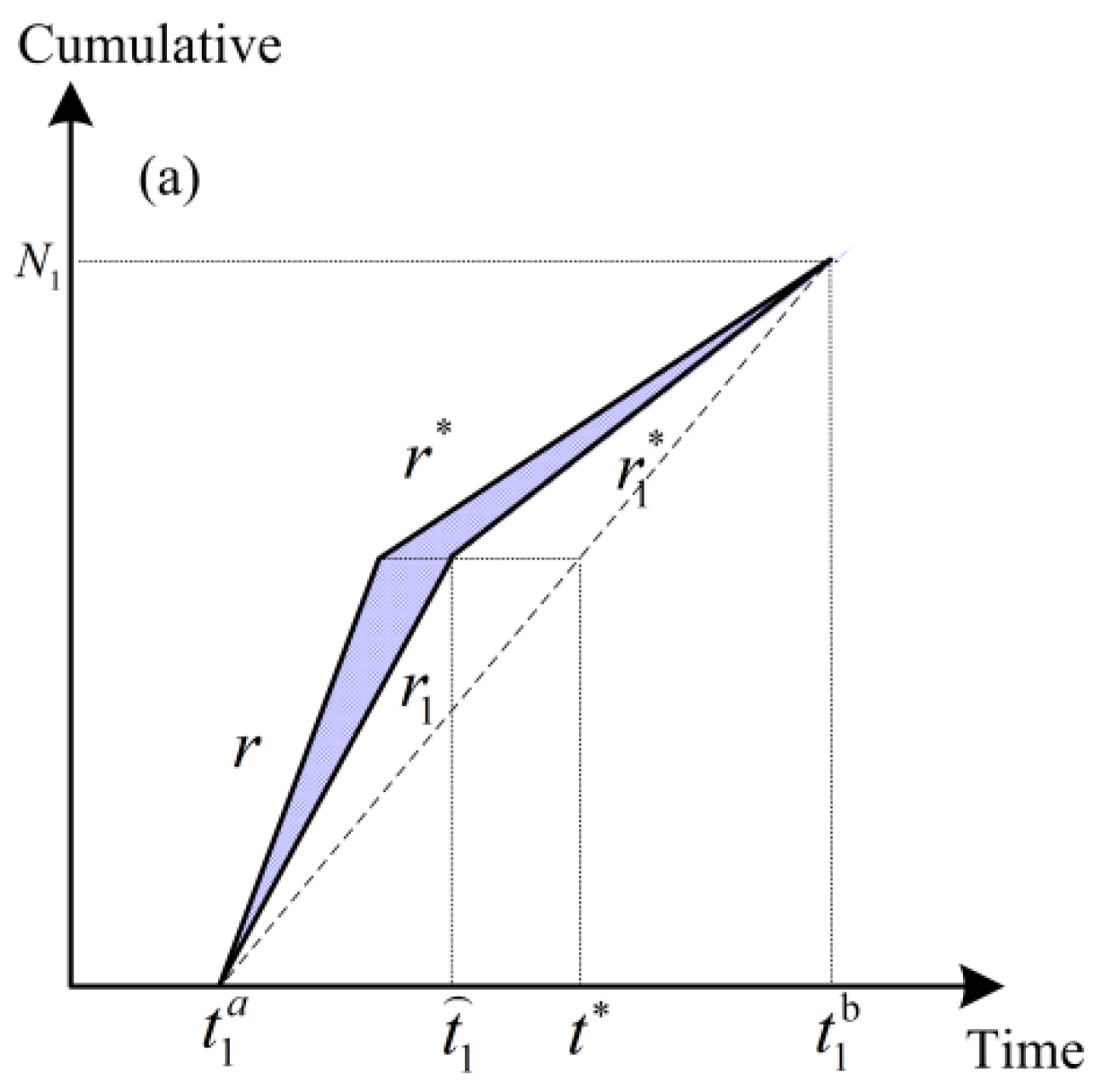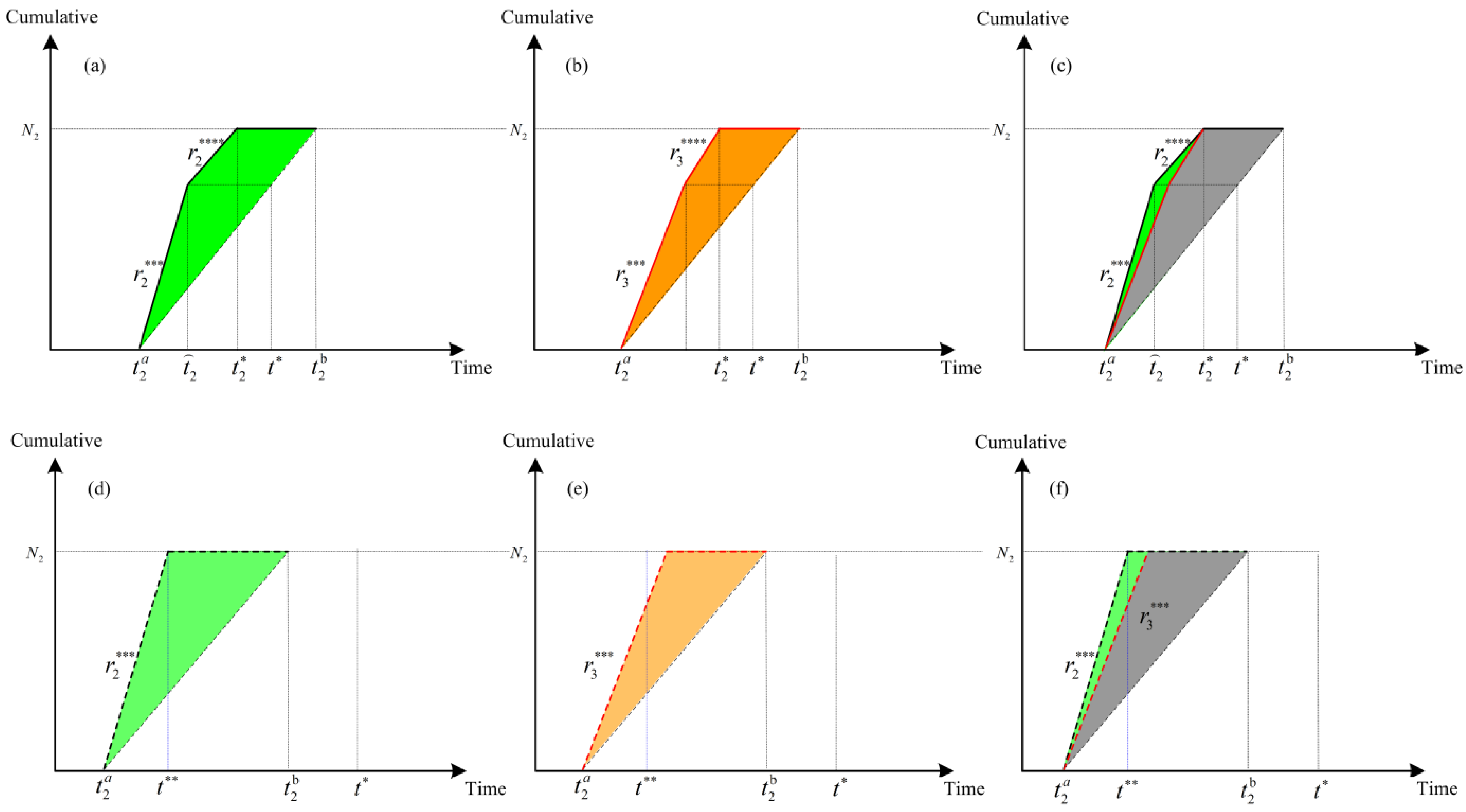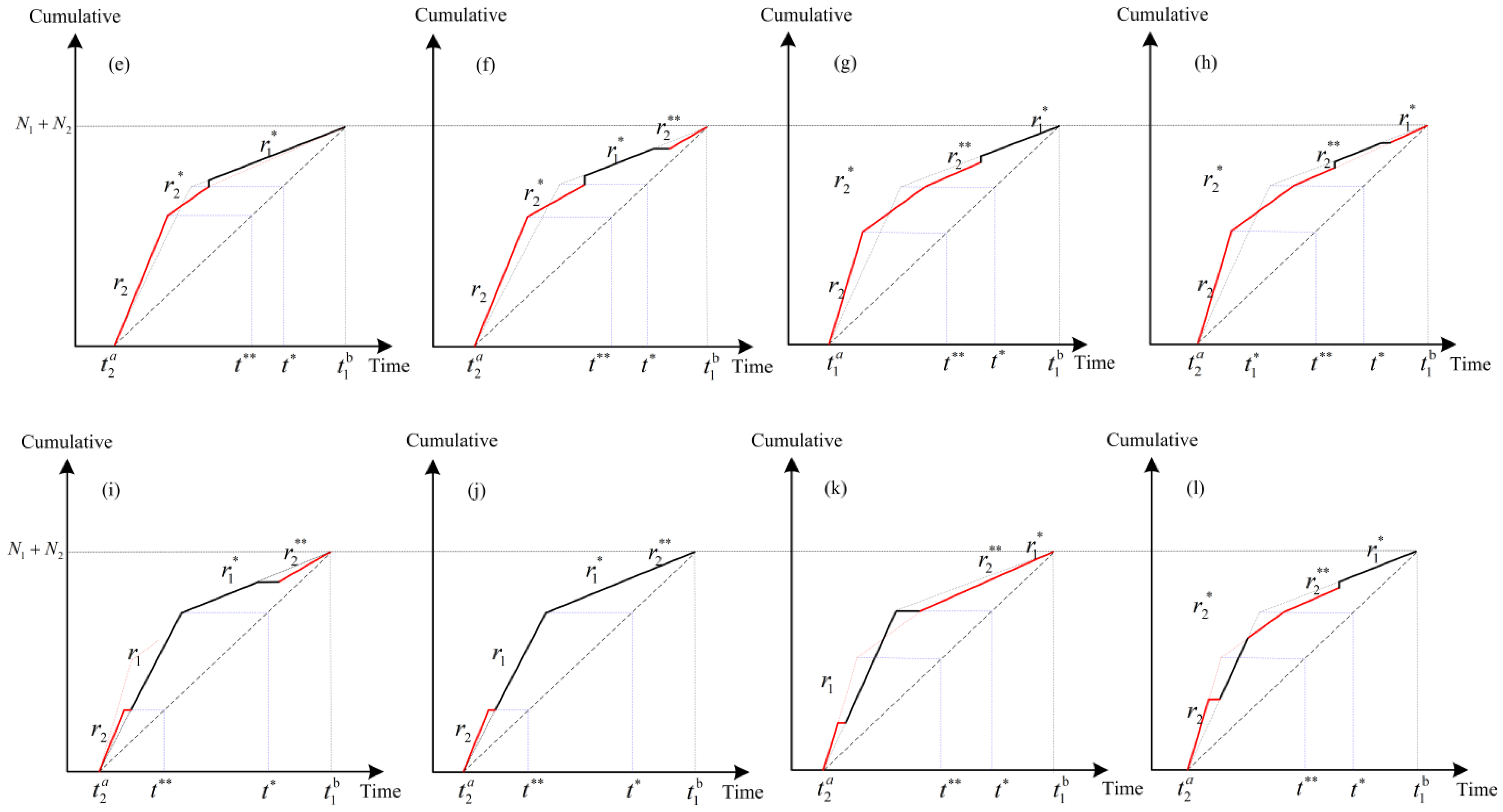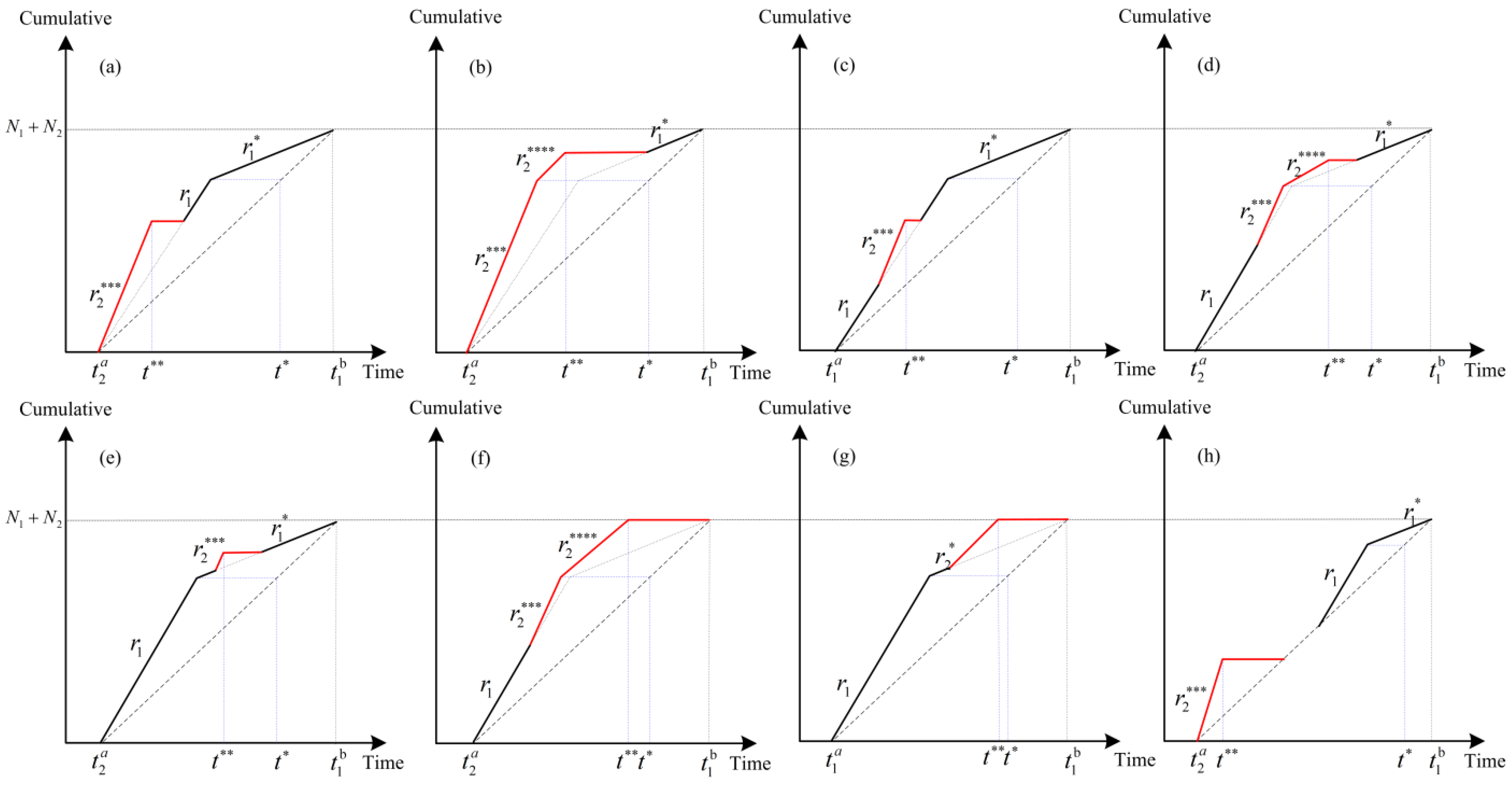The Morning Commute Problem with Ridesharing When Meet Stochastic Bottleneck
Abstract
:1. Introduction
2. Model Framework
2.1. Notations
2.2. Model Description and Mainly Assumption
- (i)
- Without loss of generality, assuming , , we can regard the length of bottleneck as the distances of OD pair in the single corridor, meanwhile, the departure time from the origin equal to the arrival time at bottleneck, the exiting time of the bottleneck is equivalent to the arrival time at CBD.
- (ii)
- Solo drivers and ridesharing participants match each other and then leave together to achieve pickup-work (PW) schedule. Traffic departure and arrival take place over the interval . According to Assumption (i), parameters , are also the earliest and the latest time for commuters entering the bottleneck, respectively.
- (iii)
- Bottleneck location in the corridor cannot be confirmed empirically in this paper because of the dynamic traffic situation. Different congestion scenarios, pre-pickup congestion or post-pickup congestion, will be used for discussion and analysis when bottleneck develops before pickup or after pickup, respectively.
- (iv)
- Assume that is the penetration rate of RD commuters, then is the number of RD commuters; is the number of SD commuters, and always holds. Notably, and denote two extreme patterns in which the mix-ridesharing system includes only SDs or only RDs, respectively.
2.3. Estimating Trip Cost: Vickrey’s Continuous-Time Schedule Penalty Model
3. DUE Scenarios in Different Commuters for Two Extreme Cases
3.1. Pattern 1: Departure Equilibrium Pattern with Only SDs
3.2. Pattern2: Departure Pattern of DUE with Only RDs
3.2.1. Departure Pattern of DUE with Only EDs in Cases of Pre-PC
3.2.2. Departure Pattern of DUE with Only EDs in Different PW Schedule Gap
4. Departure Patterns of DUE with Mixed Commuters
4.1. Single-Peaked and Double-Peaked Cases of DUE with Mixed Commuters
4.2. User Equilibrium and System Optimal
5. Conclusions
Author Contributions
Funding
Institutional Review Board Statement
Informed Consent Statement
Data Availability Statement
Conflicts of Interest
Abbreviations/Nomenclature
| Model parameters (all positive scalars) | |
| Value of time | |
| Cost of early arrival penalty | |
| Cost of late arrival penalty | |
| Energy cost parameter | |
| Fix cost of ridesharing service for passengers | |
| Penetration rate of RD commuters | |
| Unit cost of ridesharing service for passengers | |
| Desired working time | |
| Desired pickup time | |
| The punctual time interval in pickup-work(PW) schedule | |
| Capacity of the bottleneck (veh/h) | |
| Total commuting demand | |
| Time-varying variables | |
| Queue length at the bottleneck at time t | |
| The total travel time for commuters departing at time | |
| Queuing time in bottleneck departing at time | |
| The equilibrium departure rate of SDs early for work | |
| The equilibrium departure rate of SDs early for work | |
| The equilibrium departure rate of RDs with Pre-PC scenario in case: early for pick up and work | |
| The equilibrium departure rate of RDs with Pre-PC scenario in case: early for pick up but late for work | |
| The equilibrium departure rate of RDs with Pre-PC scenario in case: late for pick up and work | |
| The equilibrium departure rate of RPs with Pre-PC scenario in case: early for pick up and work | |
| The equilibrium departure rate of RPs with Pre-PC scenario in case: early for pick up but late for work | |
| The equilibrium departure rate of RPs with Pre-PC scenario in case: late for pick up and work | |
| The travel cost of SOs departing from home at time | |
| The travel cost of RDs departing from home at time | |
| The travel cost of RPs departing from home at time | |
| Intermediate notations | |
| , , | The earliest departure time for SDs, RDs and RPs, respectively |
| , , | The latest departure time for SDs, RDs and RPs, respectively |
| The punctual departure time of SDs for work | |
| The punctual departure time of RDs for pickup and work, respectively | |
| The punctual departure time of RPs for pickup and work, respectively | |
| , | Travel demand for SDs and RDs, respectively |
References
- Yang, H.; Huang, H. Carpooling and congestion pricing in a multilane highway with high-occupancy-vehicle lanes. Transp. Res. Part A Policy Pract. 1999, 33, 139–155. [Google Scholar] [CrossRef]
- Bian, Z.; Liu, X. Mechanism design for first-mile ridesharing based on personalized requirements part II: Solution algorithm for large-scale problems. Transp. Res. Part B Methodol. 2019, 120, 172–192. [Google Scholar] [CrossRef]
- Yang, H.; Hai-Jun, H. Analysis of the time-varying pricing of a bottleneck with elastic demand using optimal control theory. Transp. Res. Part B Methodol. 1997, 31, 425–440. [Google Scholar] [CrossRef]
- Zhong, L.; Zhang, K.; Marco Nie, Y.; Xu, J. Dynamic carpool in morning commute: Role of high-occupancy-vehicle (HOV) and high-occupancy-toll (HOT) lanes. Transp. Res. Part B Methodol. 2020, 135, 98–119. [Google Scholar] [CrossRef]
- Boysen, N.; Briskorn, D.; Schwerdfeger, S.; Stephan, K. Optimizing carpool formation along high-occupancy vehicle lanes. Eur. J. Oper. Res. 2021, 293, 1097–1112. [Google Scholar] [CrossRef]
- Yao, D.; He, S.; Wang, Z. A new ride-sharing model incorporating the passengers’ efforts. Nav. Res. Log. 2021, 68, 397–411. [Google Scholar] [CrossRef]
- Wang, J.; Ban, X.J.; Huang, H. Dynamic ridesharing with variable-ratio charging-compensation scheme for morning commute. Transp. Res. Part B Methodol. 2019, 122, 390–415. [Google Scholar] [CrossRef]
- Lu, W.; Quadrifoglio, L. Fair cost allocation for ridesharing services—Modeling, mathematical programming and an algorithm to find the nucleolus. Transp. Res. Part B Methodol. 2019, 121, 41–55. [Google Scholar] [CrossRef] [Green Version]
- Wang, Y.; Winter, S.; Tomko, M. Collaborative activity-based ridesharing. J. Transp. Geogr. 2018, 72, 131–138. [Google Scholar] [CrossRef]
- Wang, X.; Dessouky, M.; Ordonez, F. A pickup and delivery problem for ridesharing considering congestion. Transp. Lett. 2016, 8, 259–269. [Google Scholar] [CrossRef]
- Ma, R.; Zhang, H.M. The morning commute problem with ridesharing and dynamic parking charges. Transp. Res. Part B Methodol. 2017, 106, 345–374. [Google Scholar] [CrossRef]
- Ma, J.; Xu, M.; Meng, Q.; Cheng, L. Ridesharing user equilibrium problem under OD-based surge pricing strategy. Transp. Res. Part B Methodol. 2020, 134, 1–24. [Google Scholar] [CrossRef]
- Di, X.; Ma, R.; Liu, H.X.; Ban, X.J. A link-node reformulation of ridesharing user equilibrium with network design. Transp. Res. Part B Methodol. 2018, 112, 230–255. [Google Scholar] [CrossRef]
- Arnott, R.; de Palma, A.; Lindsey, R. Economics of a bottleneck. J. Urban Econ. 1990, 27, 111–130. [Google Scholar] [CrossRef]
- Arnott, R.; de Palma, A.; Lindsey, R. Properties of dynamic traffic equilibrium involving bottlenecks, including a paradox and metering. Transp. Sci. 1993, 27, 148–160. [Google Scholar] [CrossRef]
- Tian, L.; Sheu, J.; Huang, H. The morning commute problem with endogenous shared autonomous vehicle penetration and parking space constraint. Transp. Res. Part B Methodol. 2019, 123, 258–278. [Google Scholar] [CrossRef]
- Liu, Y.; Li, Y. Pricing scheme design of ridesharing program in morning commute problem. Transp. Res. Part C Emerg. Technol. 2017, 79, 156–177. [Google Scholar] [CrossRef]
- Filipe, P.P.; Moura, R.D. Carpooling Systems Aggregation. In Lecture Notes of the Institute for Computer Sciences, Social-Informatics and Telecommunications Engineering, LNICST; Springer: Berlin/Heidelberg, Germany, 2021; Volume 364 LNICST, pp. 52–71. [Google Scholar]
- Shen, Q.; Wang, Y.; Gifford, C. Exploring partnership between transit agency and shared mobility company: An incentive program for app-based carpooling. Transportation 2021, 6, 1–19. [Google Scholar]
- Martins, L.D.C.; de la Torre, R.; Corlu, C.G.; Juan, A.A.; Masmoudi, M.A. Optimizing ride-sharing operations in smart sustainable cities: Challenges and the need for agile algorithms. Comput. Ind. Eng. 2021, 153, 107080. [Google Scholar] [CrossRef]
- Long, J.; Tan, W.; Szeto, W.Y.; Li, Y. Ride-sharing with travel time uncertainty. Transp. Res. Part B Methodol. 2018, 118, 143–171. [Google Scholar] [CrossRef]







| Scenarios | Bottleneck before Pickup | Bottleneck after Pickup | ||||
|---|---|---|---|---|---|---|
| Extra cost | Departure rate | |||||
| Time window | ||||||
| Solo Driver | none | |||||
| gasoline | ||||||
| Time window | ||||||
| Ridesharing Driver | Gasoline&Compensation | |||||
| Ridesharing Passenger | payment | |||||
| Considering simplicity of analysis, let , , | ||||||
Publisher’s Note: MDPI stays neutral with regard to jurisdictional claims in published maps and institutional affiliations. |
© 2021 by the authors. Licensee MDPI, Basel, Switzerland. This article is an open access article distributed under the terms and conditions of the Creative Commons Attribution (CC BY) license (https://creativecommons.org/licenses/by/4.0/).
Share and Cite
Zhang, Z.; Zhang, N. The Morning Commute Problem with Ridesharing When Meet Stochastic Bottleneck. Sustainability 2021, 13, 6040. https://doi.org/10.3390/su13116040
Zhang Z, Zhang N. The Morning Commute Problem with Ridesharing When Meet Stochastic Bottleneck. Sustainability. 2021; 13(11):6040. https://doi.org/10.3390/su13116040
Chicago/Turabian StyleZhang, Zipeng, and Ning Zhang. 2021. "The Morning Commute Problem with Ridesharing When Meet Stochastic Bottleneck" Sustainability 13, no. 11: 6040. https://doi.org/10.3390/su13116040






